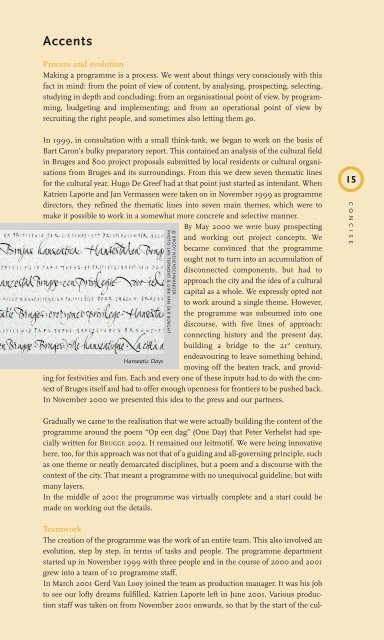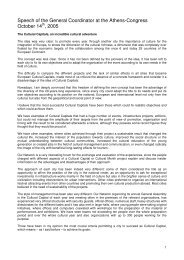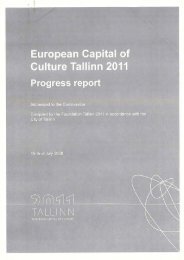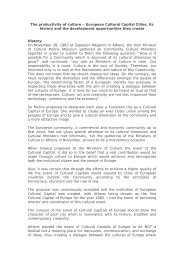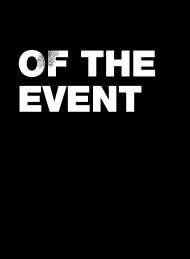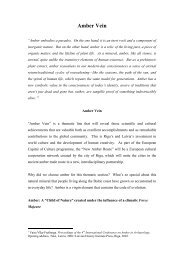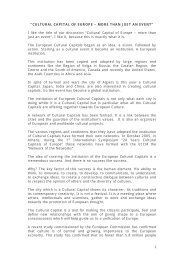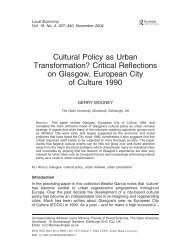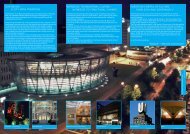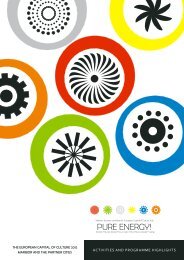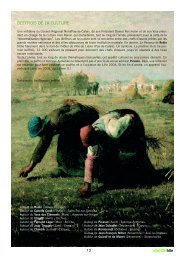Concise.pdf - Brugge Plus
Concise.pdf - Brugge Plus
Concise.pdf - Brugge Plus
- No tags were found...
Create successful ePaper yourself
Turn your PDF publications into a flip-book with our unique Google optimized e-Paper software.
Accents<br />
Process and evolution<br />
Making a programme is a process. We went about things very consciously with this<br />
fact in mind: from the point of view of content, by analysing, prospecting, selecting,<br />
studying in depth and concluding; from an organisational point of view, by programming,<br />
budgeting and implementing; and from an operational point of view by<br />
recruiting the right people, and sometimes also letting them go.<br />
In 1999, in consultation with a small think-tank, we began to work on the basis of<br />
Bart Caron’s bulky preparatory report. This contained an analysis of the cultural field<br />
in Bruges and 800 project proposals submitted by local residents or cultural organisations<br />
from Bruges and its surroundings. From this we drew seven thematic lines<br />
for the cultural year. Hugo De Greef had at that point just started as intendant. When<br />
Katrien Laporte and Jan Vermassen were taken on in November 1999 as programme<br />
directors, they refined the thematic lines into seven main themes, which were to<br />
make it possible to work in a somewhat more concrete and selective manner.<br />
© BRODY NEUENSCHWANDER<br />
PHOTO: JAN TERMONT & DIRK VAN DER BORGHT<br />
By May 2000 we were busy prospecting<br />
and working out project concepts. We<br />
became convinced that the programme<br />
ought not to turn into an accumulation of<br />
disconnected components, but had to<br />
approach the city and the idea of a cultural<br />
capital as a whole. We expressly opted not<br />
to work around a single theme. However,<br />
the programme was subsumed into one<br />
discourse, with five lines of approach:<br />
connecting history and the present day,<br />
building a bridge to the 21 st century,<br />
endeavouring to leave something behind,<br />
Hanseatic Days<br />
moving off the beaten track, and providing<br />
for festivities and fun. Each and every one of these inputs had to do with the context<br />
of Bruges itself and had to offer enough openness for frontiers to be pushed back.<br />
In November 2000 we presented this idea to the press and our partners.<br />
15<br />
CONCISE<br />
Gradually we came to the realisation that we were actually building the content of the<br />
programme around the poem “Op een dag” (One Day) that Peter Verhelst had specially<br />
written for BRUGGE 2002. It remained our leitmotif. We were being innovative<br />
here, too, for this approach was not that of a guiding and all-governing principle, such<br />
as one theme or neatly demarcated disciplines, but a poem and a discourse with the<br />
context of the city. That meant a programme with no unequivocal guideline, but with<br />
many layers.<br />
In the middle of 2001 the programme was virtually complete and a start could be<br />
made on working out the details.<br />
Teamwork<br />
The creation of the programme was the work of an entire team. This also involved an<br />
evolution, step by step, in terms of tasks and people. The programme department<br />
started up in November 1999 with three people and in the course of 2000 and 2001<br />
grew into a team of 10 programme staff.<br />
In March 2001 Gerd Van Looy joined the team as production manager. It was his job<br />
to see our lofty dreams fulfilled. Katrien Laporte left in June 2001. Various production<br />
staff was taken on from November 2001 onwards, so that by the start of the cul-


